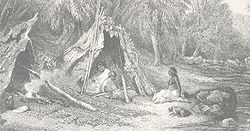
Humpy
Encyclopedia

Australian Aborigines
Australian Aborigines , also called Aboriginal Australians, from the latin ab originem , are people who are indigenous to most of the Australian continentthat is, to mainland Australia and the island of Tasmania...
, with a standing tree usually used as the main support. The word humpy comes from the Jagera
Jagera
Jagera is a genus of 4 species of small tree in the soapberry family Sapindaceae. Three are found in the rainforests of eastern Australia, the other is found in the Moluccas and New Guinea....
language (a Murri people from Coorparoo
Coorparoo, Queensland
Coorparoo is a southern suburb of Brisbane, Queensland, Australia, located approximately four kilometres from the city. Surrounding suburbs include Camp Hill, Holland Park, Greenslopes, East Brisbane, Norman Park and Seven Hills.-Aboriginal history:...
in Brisbane
Brisbane
Brisbane is the capital and most populous city in the Australian state of Queensland and the third most populous city in Australia. Brisbane's metropolitan area has a population of over 2 million, and the South East Queensland urban conurbation, centred around Brisbane, encompasses a population of...
); other language groups
Australian Aboriginal languages
The Australian Aboriginal languages comprise several language families and isolates native to the Australian Aborigines of Australia and a few nearby islands, but by convention excluding the languages of Tasmania and the Torres Strait Islanders...
would have different names for the structure.
The word humpy was adopted by early white settlers, and now forms part of the Australian lexicon
Australian English vocabulary
Many works giving an overview of Australian English have been published; many of these are humour books designed for tourists or as novelties.One of the first was Karl Lentzner's Dictionary of the Slang-English of Australia and of Some Mixed Languages in 1892. The first dictionary based on...
. Small impermanent dwellings, made of branches and bark (particularly paperbark
Melaleuca
Melaleuca is a genus of plants in the myrtle family Myrtaceae known for its natural soothing and cleansing properties. There are well over 200 recognised species, most of which are endemic to Australia...
) were built prior to the construction of more permanent buildings, and were referred to as humpies.
It is sometimes called a lean-to
Lean-to
A lean-to is a term used to describe a roof with a single slope. The term also applies to a variety of structures that are built using a lean-to roof....
, since it can rely on the tree for support.
In South Australia
South Australia
South Australia is a state of Australia in the southern central part of the country. It covers some of the most arid parts of the continent; with a total land area of , it is the fourth largest of Australia's six states and two territories.South Australia shares borders with all of the mainland...
, such a shelter is known as a "wurley" (also spelled "wurlie"), possibly from the Kaurna
Kaurna language
"Kaurna" is the language of the Kaurna people, an Australian aboriginal ethnic group, in South Australia. It was historically spoken on the Adelaide Plains from Crystal Brook and Clare in the north, to Cape Jervis in the south. It became extinct in the 19th century but was revived and reconstructed...
language. The name "gunya" is also used.
See also
- HoganHoganA hogan is the primary traditional home of the Navajo people. Other traditional structures include the summer shelter, the underground home, and the sweat house...
- IglooIglooAn igloo or snowhouse is a type of shelter built of snow, originally built by the Inuit....
- LavvuLavvuLavvu is a temporary dwelling used by the Sami people of northern Scandinavia. It has a design similar to a Native American tipi but is less vertical and more stable in high winds. It enables the indigenous cultures of the treeless plains of northern Scandinavia and the high arctic of Eurasia to...
- Longhouse
- Bender tentBender tentA bender tent is a simple shelter. A bender is made using flexible branches or withies, such as those of hazel or willow. These are lodged in the ground, then bent and woven together to form a strong dome-shape. The dome is then covered using any tarpaulin available...
- Sibley tentSibley tentThe Sibley tent was invented by the American military officer Henry Hopkins Sibley and patented in 1856. Of conical design, it stands about twelve feet high and eighteen feet in diameter. It can comfortably house about a dozen men....
- TipiTipiA tipi is a Lakota name for a conical tent traditionally made of animal skins and wooden poles used by the nomadic tribes and sedentary tribal dwellers of the Great Plains...
- WigwamWigwamA wigwam or wickiup is a domed room dwelling used by certain Native American tribes. The term wickiup is generally used to label these kinds of dwellings in American Southwest and West. Wigwam is usually applied to these structures in the American Northeast...
- YarangaYarangaA Yaranga is a tent-like traditional mobile home of some nomadic Northern indigenous peoples of Russia, such as Chukchi and Siberian Yupik.A Yaranga is a cone-shaped or rounded reindeer-hide tent. It is built of a light wooden frame covered with reindeer skins or canvas sewn together.The word...
- YurtYurtA yurt is a portable, bent wood-framed dwelling structure traditionally used by Turkic nomads in the steppes of Central Asia. The structure comprises a crown or compression wheel usually steam bent, supported by roof ribs which are bent down at the end where they meet the lattice wall...

